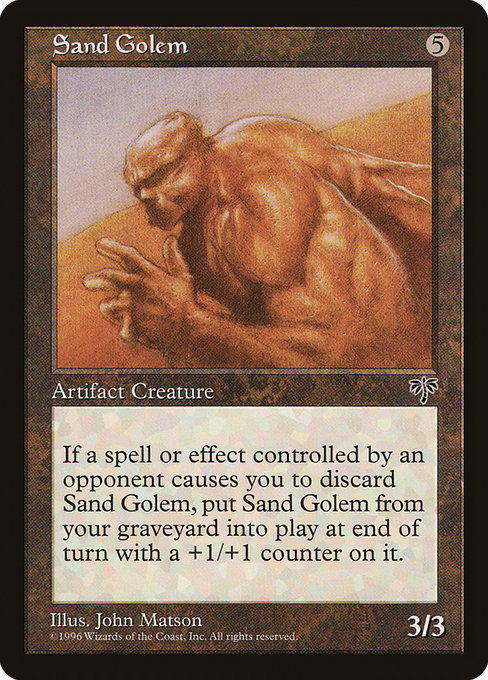
Image courtesy of Scryfall.com
Sand Golem and the Archetypes Shaped by Shared Effects
When we dip into Mirage era MTG, we’re treated to a desert-toned landscape where colorless artifacts like Sand Golem anchor the midgame, offering raw resilience and surprising recursion. This uncommon artifact creature—a 5-mana 3/3 Golem—embodies a design philosophy that many players lean on today: build around a shared mechanic, then spin five or six archetypes from that single thread. Sand Golem’s trigger is a perfect example of how an old, seemingly modest ability can catalyze modern thinking about archetypes built around similar effects 🧙♂️🔥💎.
When a spell or ability an opponent controls causes you to discard this card, return this card from your graveyard to the battlefield with a +1/+1 counter on it at the beginning of the next end step.
That line of text invites a kind of rhythmic gameplay. Opponents fire off discard or disruption, and you answer by stoking a small, stubborn engine in the graveyard. The Golem’s +1/+1 counter on reentry is not merely flavor; it’s a deliberate nudge toward late-game inevitability. In conversations about deck design, this card offers a blueprint: centralize a shared effect (in this case, opponent-caused discard) and engineer multiple archetypes around how that effect interacts with the graveyard, the board, and the tempo of the game 🧙♂️🎲.
Discard-driven resilience: turning forced loss into lasting value
One prominent path is the discard-centric archetype. Cards that pressure your opponent to discard or that force discard on your adversary’s turn create windows where Sand Golem ticks toward a payoff. The beauty here is the dynamic timing: your opponent’s spell or ability might be aimed at you as a whole, but it’s your Sand Golem that flips the script from “one-off value” to “repeated entry.” Because the Golem returns from the graveyard with a +1/+1 counter, the longer the game endures, the more threatening it becomes—especially if you’ve curated ways to protect it from a swift bounce or exile. This is classic midrange control meeting graveyard resilience, with a desert-flavored twist that feels nostalgic yet surprisingly current in multiplayer formats. The synergy isn’t about one flashy combo; it’s about a consistent stream of value you can shoulder into late game with a stubborn defender in the form of a reanimated artifact creature 🧙♂️⚔️.
Graveyard recursion as a narrative engine
Mirage’s Sand Golem leans into a broader narrative of reuse and reclamation. In archetypes built around similar effects, players often pair cards that fill the graveyard, then rely on reanimation or retrievable threats to push past stalemates. The Golem’s delayed return (the “beginning of the next end step” timing) creates a steady tempo that rewards patient play, careful sequencing, and predicting when opponents will need to disrupt your plan rather than leap ahead themselves. It’s not just about getting a body back; it’s about getting a version of that body back bigger and better, ready to loom over the board as a 3/3 that’s fed by your graveyard’s hidden reservoir 🧙♂️💎.
Artifact-synergy and resilient design
As a colorless artifact creature, Sand Golem slots into decks that lean on artifact synergies—think ways to protect artifacts, accelerate their entry, or reintroduce them after removal. The Mirage era embraced artifact-rich landscapes, and the Golem benefits from that era’s preference for resilient threats that outlast removal in slower, more deliberate formats. Even today, the concept translates into modern designs: an artifact creature with a built-in graveyard recursion engine is a flexible piece that can anchor a variety of shells, from prison-style setups to more aggressive discard-recur strategies. Its 5-mana cost is a reminder that sometimes a durable, late-game threat is worth paying extra mana to secure, especially when it can return stronger after a disruption spell lands on it 🎨🎲.
Art, lore, and a design ethos you can feel
John Matson’s illustration for Sand Golem captures an old desert forge vibe—the kind of imagery that makes players imagine what a golem would feel like trudging across dunes under a blazing sky. Mirage as a set carried a distinctive frame and narrative texture, and the Sand Golem stands as a quiet ambassador for design choices that favored resilience, late-game resilience, and a sense of discovery as you learned the value of “recurring threats.” The card’s look, mechanics, and rarity (uncommon, colorless, nonfoil) make it a collectible echo of a very different MTG era—one that still informs how we think about similar effects today. If you’re drawn to deckbuilding that rewards careful curation over brute force, the Sand Golem is a gentle, iconic reminder that clever reuse beats raw speed when the plan comes together 🧙♂️🔥.
From a collector’s perspective, Mirage-era cards like Sand Golem occupy a curious spot. They’re not the flashiest reprint kings, and their nonfoil status often keeps price modest—yet their design still holds a lot of instructional value for players exploring archetypes built around shared effects. Current market data places Sand Golem as an affordable curiosity (roughly a few dollars or less in many listings), but its true value lies in the lessons it teaches: the elegance of a single mechanic expanded into multiple viable pathways, and the joy of seeing a well-timed reentry turn the tide of a long game. If you’re drafting or building in casual to vintage-leaning formats, Sand Golem’s archetype-driven approach remains a compelling blueprint 🧙♂️⚔️💎.
Interested in exploring more about how shared effects shape deck design and brand identity across MTG spaces? The following articles across our network offer perspectives on design patterns, identity guidelines, and the cultural lens through which we view cards like Sand Golem:
Product spotlight and move-to-action
For enthusiasts who love tactile, everyday-carry MTG gear that’s as functional as a well-timed play, check out the featured product below. It’s a fun cross-promotion that blends a real-world utility with the spirit of the game—a nod to how the MTG community loves to collect and share across platforms.
Phone Grip Kickstand Click-On HolderMore from our network
- https://blog.digital-vault.xyz/blog/post/crafting-strong-brand-guidelines-for-consistent-identity/
- https://blog.digital-vault.xyz/blog/post/across-un-sets-meta-design-patterns-for-implement-of-malice/
- https://blog.digital-vault.xyz/blog/post/blue-giant-in-cygnus-probes-data-coverage-of-a-sky-survey/
- https://crypto-acolytes.xyz/blog/post/best-retro-games-with-unforgettable-stories/
- https://blog.digital-vault.xyz/blog/post/analyzing-traumatic-visions-engagement-across-mtg-archetypes/